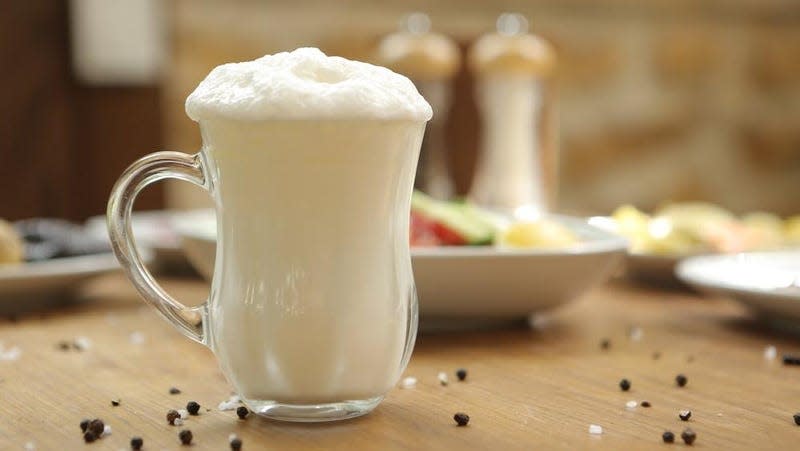What Are Probiotics, Exactly?

As I pondered a mid-morning snack recently, the yogurt stared at me, as it always does, from the fridge. “Eat me!” it seemed to implore. “I’m full of liiiiiive culllltuuuuures.” Sometimes yogurt really hits the spot, and sometimes I’m a little freaked out by it. But no matter where my cravings take me, the yogurt label always blares that it’s full of probiotics—whatever that means.
Probiotics are virtually always mentioned as a sort of shorthand for foods that provide nutritional value. Probiotic soda like Olipop, for example, is a hugely popular item in health food stores. I know what antibiotics are. I know what “symbiotic” means. But I’m not actually sure what probiotics are, and even less sure about prebiotics. So I asked Sheryl Kesey Thompson, co-owner of Springfield Creamery, maker of Nancy’s Probiotic Foods, for assistance.
A brief history of probiotics
Probiotics were first discovered in Bulgarian yogurt in 1905, and soon afterward Nobel Laureate Élie Metchnikoff made the connection between Bulgarians who ate yogurt containing live bacteria and those who lived longer. Later, in the U.S., Thompson’s father, Chuck Kesey, studied Dairy Science at Oregon State University with a focus on the benefits of live probiotics, including Lactobacillus acidophilus. This bacteria is found in the human mouth and gastrointestinal tract, and it’s also present in both milk and yogurt.
Kesey opened Springfield Creamery in 1960 and introduced Nancy’s Yogurt in 1970—“the first yogurt sold in the U.S. to contain live probiotics,” Thompson explains.
There has been some disagreement about whether products that include probiotics can definitively claim health benefits; Europe in particular places restrictions on touting such health claims. In the United States, the National Yogurt Association at one time managed the regulation of yogurt packaging, but that trade organization was dissolved in 2019. Now the International Dairy Foods Association is in charge of yogurt.
What does it mean for a food to contain probiotics?
I took Latin, and here it is being put to use (finally): “Pro” is good (technically “for,” as in, “I’m for yogurt,” aka “I’m pro yogurt”). “Bio” is life. And “ic,” not to be confused with “ick,” turns a word into an adjective. So a probiotic must be something that... makes... life... good?
Not so simple, says Thompson. While probiotics are live cultures, she clarifies that not all live cultures are probiotics; the broader term “live cultures” applies to any microorganisms that help ferment food. Probiotics specifically, though, “are often referred to as ‘good’ or ‘friendly’ bacteria because they help maintain a healthy balance of microorganisms in the gut.”
“These living microbial superstars help stimulate our immune system and support our digestive health,” she says. Again, they’re aliiiiive.
You can get many foods with probiotics as well as probiotic supplements, but yogurt is one of the main sources, as is kefir. Other cultured foods are sources of probiotics, too, including kimchi, miso, tempeh, and kombucha. Thompson says health benefits occur in food with billions of probiotics, not millions. “Foods with billions of live cultures will have that characteristic probiotic tang that tells you you’re eating real food, not something heavily processed,” she says.
The National Center for Complementary and Integrative Health (NCCIH) maintains that while there has been a lot of promising research in the area of probiotics, there’s also a lot left to be learned about this area of food science and health.
“Probiotics have shown promise for a variety of health purposes, including prevention of antibiotic-associated diarrhea (including diarrhea caused by Clostridium difficile),” the NCCIH notes. “However, in most instances, we still don’t know which probiotics are helpful and which are not. We also don’t know how much of the probiotic people would have to take or who would be most likely to benefit. Even for the conditions that have been studied the most, researchers are still working toward finding the answers to these questions.”
What about prebiotics?
Using that handy Latin again, “pre” means before, so prebiotics are something that exists before life, right? Wrong again. Turn in your silver National Latin Exam award.
“Prebiotics are dietary plant fibers that feed your gut’s healthy bacteria,” Thompson explains. These non-digestible substances aren’t alive like probiotics are; instead, they exist to stimulate the growth and/or activity of the “good” bacteria living in our gut, which in turn helps maintain our microbiome.
One example of a prebiotic that’s used in some of Nancy’s products is organic chicory root inulin, but Thompson notes they also occur naturally as plant fibers in various fruits, vegetables, whole grains, and legumes.
The bottom line on probiotics
Probiotics, in high numbers especially, can add nutrition to food. No one can yet claim that they cure or prevent any diseases, but many people find that probiotics help them with a variety of everyday health issues. You have perhaps been told by a doctor to eat more yogurt when taking antibiotics, for example, because the probiotics can keep your gut bacteria functioning well.
More than any of the potential health benefits, foods containing probiotics can simply be nutritious and delicious. So if you happen to enjoy a mid-morning yogurt and a side of kimchi at lunch, bon appétit.

